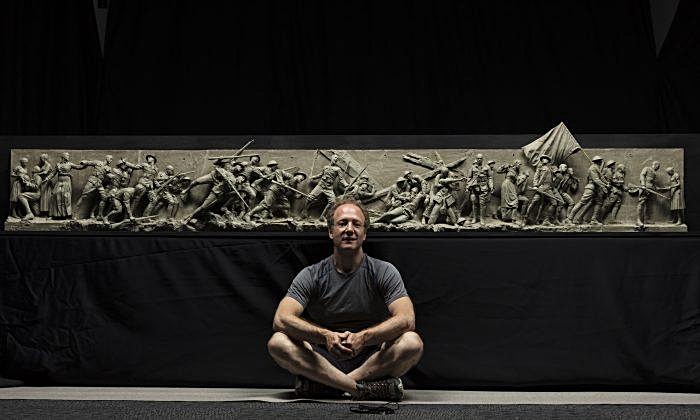Stretching across 58 feet in Pershing Park in Washington, D.C., stands a remarkable bronze frieze that depicts a Soldier’s Journey during the challenging and perilous times of World War I. Consisting of 38 life-size human figures positioned from left to right, this artwork portrays the experience of an individual American soldier throughout his departure from home, the struggles faced in battle, the aftermath, and his eventual return.
The immense creation by sculptor Sabin Howard, an Italian American artist, was unveiled in an illuminating ceremony on September 13. Howard, known for his dedication to revive figurative sculpture in line with the grand tradition of the Renaissance, finds it deeply ironic that he effectively presents his case through a large-scale piece commemorating World War I.

This monumental war marked the end of the philosophical notion that the world is unified through a divine order. With the devastating loss of 22 million lives, a shift towards alienation and nihilism occurred, leading to the demise of religious beliefs and the inception of the modern era. Howard reflects on the tremendous impact this period had on art, where the significance of figurative representation began to fade. Following World War I, the art world progressively shifted away from the prominence of the human figure. While the last significant attention given to the figure was during the Art Deco movement, subsequent developments led to the rise of abstract art.

Born in 1963 in New York, Sabin Howard, the man, came to be. However, Sabin Howard, the sculptor, was conceived at precisely 4 p.m. on October 22, 1982.
At that moment, I made the life-changing decision to become an artist. Working at a cabinet-making shop, I called my father to share the news. His response was skeptical, asking, “How long will this last?” So far, it has lasted 42 years and counting. At the age of 19, Howard found himself unfamiliar with drawing techniques and the protocols of the art world. Inquiring about the requirements, he contacted an art school and was informed about the necessity of a portfolio. However, he was oblivious to what a portfolio entailed.

Driven by his dedication to the Renaissance and figurative art, Howard remains committed to certain core values. He believes that art springs from personal experience, shaped by the divine nature of the universe’s organization. Artists take inspirations from this sacred element, creating representations that reflect our potential as human beings.
Howard’s earliest creations consisted of sculptures depicting ancient deities, including Hermes and Aphrodite. In 2011, he completed the masterpiece he was convinced would bring him recognition in the art world. This piece, titled “Apollo,” featured a male nude form that required 3,500 hours of work and the collaboration of two models. Comparing his creation to the works of the Italian Renaissance, Howard felt he had accomplished something truly significant.

Embarking on the sculpture in January 2016, Howard devoted eight and a half years to its completion.

During this time, countless meetings with the commission took place, resulting in 25 different iterations of the sculpture. A 10-foot maquette and a subsequent 5-foot version were also created before final approval was granted. Howard describes this process as a battle.
One of the commission members suggested that Howard study Henry Shrady’s bronze statue of Ulysses S. Grant, which was unveiled in 1924 and situated at the base of Capitol Hill. Intrigued by this recommendation, Howard saw it as a template he could follow.


Howard called his creation “A Soldier’s Journey,” highlighting its departure from sculptures exclusively commissioned by elites and governments. He intended for anyone to connect with the artwork. Whether an eighth-grader uninterested in art or an art enthusiast, all individuals can be captivated by this captivating bronze narrative that unfolds seamlessly as one walks from left to right.
The narrative commences with a man bidding farewell to his wife and daughter, as the daughter hands him his helmet. The journey progresses to scenes of intense combat, witnessing the protagonist amidst a backdrop of death, injuries, and gas attacks. Subsequently, the artwork depicts the solemn aftermath of battle and the soldier’s eventual return to his wife and daughter.

As the story unfolds from left to right, the protagonist’s face evolves to reflect the diverse races and ethnic groups that participated in the war effort.
Traci Slatton Howard, a novelist and Sabin Howard’s wife, highlighted the parallels between the implied narrative of the sculpture and the archetypal hero’s journey, which resonates universally with the human experience.
Completing this enormous sculpture after nearly a decade of continuous work left Howard at a loss of what to do next. Consequently, he embarked on writing a 750-page book chronicling the entirety of his experience.
Howard envisions “A Soldier’s Journey” as the starting point to potentially shift the art world’s focus from abstract to figurative sculpture. He does not shy away from expressing his firm belief that schools, art critics, galleries, and museums often demonstrate arrogance and ignorance when it comes to acknowledging what true art represents.
To rectify the current state, Howard emphasizes the need to reconnect with the divine essence inherently present within human nature itself.
Discover more from Tension News
Subscribe to get the latest posts sent to your email.

